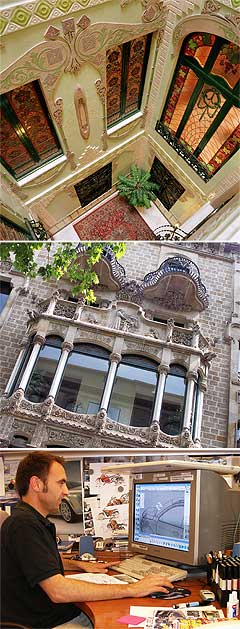Make / Model Search
News - VolvoVolvo's new outlookHip: Volvo's 100-year-old design centre in Barcelona, Spain. A rejuvenated Volvo turns to Spain for its small-car design inspiration15 Dec 2006 THE winds of change may be blowing through Volvo in Sweden, but it is the front door of the Ford-owned marque’s hip Barcelona design centre that heralds the extent of this change. The small Barcelona operation is housed in one of the city’s more impressive buildings, a former city villa known as Casa Berenguer, Diputacion no 246. It was built in 1907 by a wealthy Catalan family with influences of Gaudi and Moorish architecture. The family operated a successful textile business in the city and much of the building’s interior decoration reflects this textile background. There is no stainless steel, no wood panelling and no aesthetic minimalism. In fact, it is very un-Volvo. And for David Ancona, the centre’s chief designer and studio manager, this is how it should be. His office, too, is also exactly where he wants it to be – in the centre of this historic city’s lively CBD, not in some suburban industrial area. Casa Berenguer’s arched double front doors, with their detailed stained glass windows, the pink-and-white carrera marble floor and the wrought-iron work are evidence of the "new" Swede for the 21st century. The "boxy" image that once quantified Volvo cars is now well and truly a thing of the past. Volvo’s Barcelona centre is one of three studios around the globe the others are at Camarillo in California and Volvo’s Gothenburg headquarters in Sweden. "We are Swedish but we need a global footprint," Mr Ancona said. The three studios are a perfect fit with where Volvo sees its future. Northern America has a large-car culture, while northern Europe has a medium-car culture and southern Europe – including Spain – has a small-car culture.  The Volvo studio’s work is responsible for two areas of operation – strategic design and project work. Strategic design looks at concept cars and pre-project development, while the project work looks at more immediate next-generation vehicles. The Volvo studio’s work is responsible for two areas of operation – strategic design and project work. Strategic design looks at concept cars and pre-project development, while the project work looks at more immediate next-generation vehicles.Mr Ancona said the strategic work was involved in concept cars right up to 2015 while his team’s project work looked at vehicles that may be on the road within a timeframe as short as four years. The idea behind locating a satellite studio in Barcelona’s downtown area was simple. Mr Ancona said Volvo wanted its designers closer to the action – in closer contact with its customers. "Normally, design is next to the engineering facility, which is next to the factory," he said. "They tend to be not very inspiring and the designers also tend to be surrounded by their own products." Today, a satellite studio like Volvo’s Barcelona centre is a cost-effective venture. The floor space is leased, not owned, and today’s world of digital processes in design mean a studio can virtually be located anywhere in the globe at a relatively low cost. Volvo is set to open another smaller studio in China in the near future. The Barcelona centre employs 10 staff, including six designers and two clay modellers. "It is cheaper to work here than in Gothenburg," Mr Ancona said. "And the golden rule from day one was that we had to have at least 50 per cent local content, which meant Spanish designers." For Mr Ancona, Spain is becoming a centre for design, moving away from the traditionally held Italian automotive styling studios. "Italian design of the 1950s has moved on – today the industry seems to be more interested in branding rather than design," Mr Ancona said. A gauge of the Barcelona’s impact on Volvo design is the C30. The studio was involved in the very early stages of the C30 three-door coupe soon after it opened in 2001. Apart from Volvo, Audi and Renault have studios in Spain, and Mr Ancona believes it will not be long before Barcelona becomes the new design centre of southern Europe, based on the impact Spanish design is having globally across a range of consumer items, from furniture to food. According to Mr Ancona, Barcelona has a history of design in the areas of art, architecture, furniture and graphics, but little in the way of specific product design, except perhaps for the famed minimalist 1929 leather and chrome Barcelona chair by Ludwig Miese van der Rohe. Despite the studio’s historic location, there is still an over-riding feeling at Volvo to maintain its adherence to minimalism design. But according to Mr Ancona, the days of Volvos being driven by "uni professors and vicars" is well and truly over. |
Click to shareVolvo articlesResearch Volvo Motor industry news |









Facebook Twitter Instagram